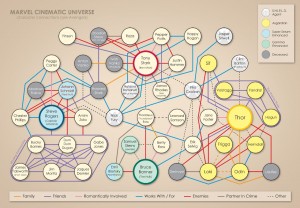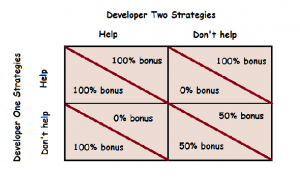Collaboration Network of Masked Vigilantes
The formation of networks and connections is governed by a wide assortment of contexts. Some networks are a departure from the rampant social networks tracing the globe these days. Collaboration networks in which the edges stem from collaboration between the nodes, are examples of such networks. When I was deliberating over some multifaceted networks, I was reminded of the Marvel Universe, which despite being an artificial world, doubtlessly mimics real life networks and their properties. The Marvel Universe has a striking 8000 named(significant) characters, many of who have interestingly been featured together in several comics. It is as if their adventures occur in the same macrocosm.
The following image shows links between a small subset of the characters. The blue edges represent the collaboration network. These vigilantes are connected by direct links or through some “S.H.I.E.L.D” agent to each other, vitally because of a common goal, rather than friendship.
This seemed like a perfect specimen of focal closure, where a common focus, brings two nodes/people together. Looking at the broader picture, these links also form a membership network called the “Avengers”. The Marvel Universe also seems to comply with the Structural Balance theory, in that each edge between these superheroes is a positive tie and all the superheroes have negative ties with the villains.
In real life scenarios one good example of collaboration networks, that also involves a bit of game theory, would be Agile Software Development.When two developers work together where there is no common code ownership,
1) If the developers don’t collaborate, they get only half of their yearly bonus.
2)If one developer helps the other one without reciprocity, the one getting the help will be on time and get 100% of his bonus. The helper however will be the only one running late, he will be considered solely responsible for the whole project going overboard and he will get no bonus.
3)If both collaborate with each other, the project will be delivered on time, both get 100% of their bonus, and everybody wins.
So do they collaborate?
Non-collaborative strategy is a Nash Equilibrium in this case. However nothing prevents the developers from meeting with their managers, reaching a new Nash Equilibrium that benefits both parties. If say, the project is not delivered on time, and nobody gets a bonus, then the best action would be for them to cooperate. This is what DevOps today are based on. This strategy clearly expands the sphere of collaboration networks.
Links- http://java.dzone.com/articles/devops-prisoner%E2%80%99s-dilemma
http://new.livestream.com/accounts/646193/events/2474611


